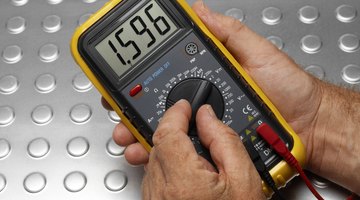How to Check a Throttle Position Sensor
Throttle Position Sensors (TPSs) are relatively simple devices. TPS is a fancy new name for the old three-terminal potentiometer that is commonly known by many different names. Volume controls, tone controls, and balance controls are all three-terminal potentiometers.

It is nothing more than a variable resistor and can be checked with Digital Multimeter (DMM).
A faulty TPS may be the cause of many drive-ability problems. Unexpected stalling, rough idle, hesitation upon accelerating, or unexplained acceleration while cruising at a steady speed are all symptoms of a defective TPS.
Things You Will Need
- Digital Multimeter (DMM)
- Alligator clip test leads
-
Disconnect the TPS connector. There are three wires going to the sensor body, the negative ground, the +12 Volt input, and the variable output to the onboard computer.
-
Insert the alligator clip test leads into the appropriate jacks on your DMM and set the "Range Switch" to the 20,000-Ohm or the 20K Ohm scale.
-
Connect one of the test leads to the center connector, the computer output connector, and the other lead to either the +12 volt or the – Ground connector on the TPS connector. The polarity of the test probes doesn't matter when making this test.
-
Slowly, move the throttle through its full range of movement from its "closed" position to its "full open" position, while observing the digital readout on the DMM. It should increase or decrease steadily and evenly as the throttle linkage is moved through its full range. Any sudden drops or increases in the reading indicates a bad TPS which needs to be replaced. A drop to infinite resistance at any point indicates a break in the TPS's resistance element and also indicates a bad TPS.
Tip
The actual resistance of the TPS varies from one make to another, so the steady, smooth increase and decrease of the readout is more meaningful than the actual maximum reading when testing a TPS.
The Drip Cap
- Throttle Position Sensors (TPSs) are relatively simple devices.
- Volume controls, tone controls, and balance controls are all three-terminal potentiometers.
- Connect one of the test leads to the center connector, the computer output connector, and the other lead to either the +12 volt or the – Ground connector on the TPS connector.
- Any sudden drops or increases in the reading indicates a bad TPS which needs to be replaced.
References
Resources
Writer Bio
Based in Colorado Springs, Colo., Jerry Walch has been writing articles for the DIY market since 1974. His work has appeared in “Family Handyman” magazine, “Popular Science,” "Popular Mechanics," “Handy” and other publications. Walch spent 40 years working in the electrical trades and holds an Associate of Applied Science in applied electrical engineering technology from Alvin Junior College.
Photo Credits
- Polka Dot Images/Polka Dot/Getty Images
- Polka Dot Images/Polka Dot/Getty Images
More Articles



